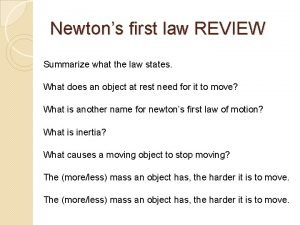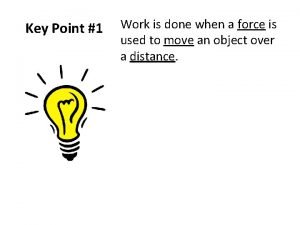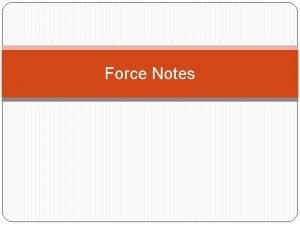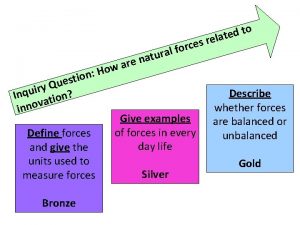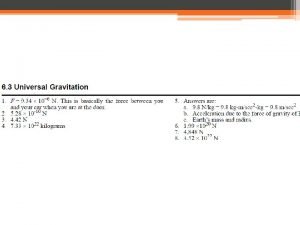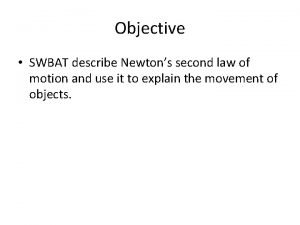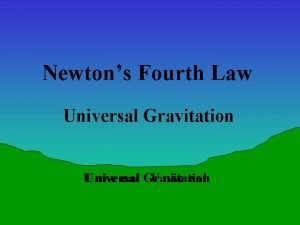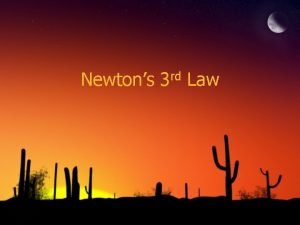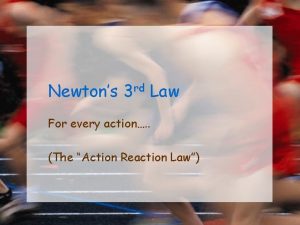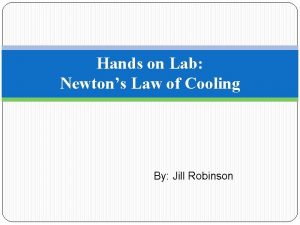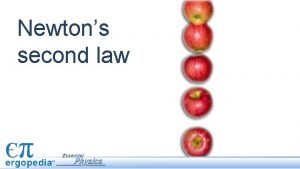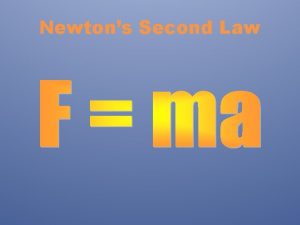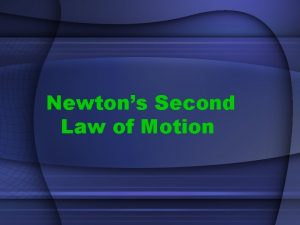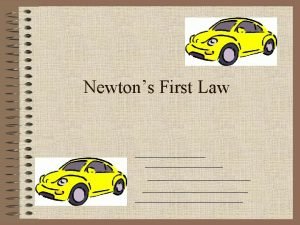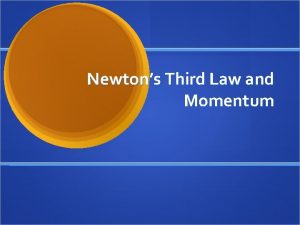nd 2 Newtons Law If a net force



![1/ Units: a = Fnet = units: Fnet m ma [N] = [kg] [m/s 1/ Units: a = Fnet = units: Fnet m ma [N] = [kg] [m/s](https://slidetodoc.com/presentation_image/62a05edad70281bf7814a9da3266daa8/image-4.jpg)










- Slides: 14

nd 2 Newton’s _____ Law: If a net force Fnet acts on an object of mass m, the object’s acceleration a will be: a= Fnet cause accelerations Net forces __________ m resists acceleration mass ____________ a a Fnet Compare: a = Δv/t m is a _________ of a a = Fnet/m tells the_______ of a


nd 2 Newton’s _____ Law: If a net force Fnet acts on an object of mass m, the object’s acceleration a will be: a= a Fnet cause accelerations Net forces __________ m resists acceleration mass ____________ a direct inverse Fnet m definitionof a is a _________ cause of a a = Fnet/m tells the_______ Compare: a = Δv/t
![1 Units a Fnet units Fnet m ma N kg ms 1/ Units: a = Fnet = units: Fnet m ma [N] = [kg] [m/s](https://slidetodoc.com/presentation_image/62a05edad70281bf7814a9da3266daa8/image-4.jpg)
1/ Units: a = Fnet = units: Fnet m ma [N] = [kg] [m/s 2] [N] = [kg m/s 2] derived fundamental net force that produces an acceleration 1 N = the _______ 1 m/s 2 when applied to a mass of _____1 kg. of _____ 1 N 1 kg frictionless surface

2/ a is a vector: a = 5. 0 m/s 2, east magn. dir. a/ The magnitude of a is also called acceleration the____________. Ex. Names of vectors and their magnitudes. vector magnitude displacement distance velocity speed acceleration

the same as the b/ The direction of a is ________ direction of Fnet. Ex: In free fall, the weight w equals ____ Fnet. What is the acceleration at all five points shown? 9. 81 m/s 2 magn. : a = __ =g ______ w w down because it is dir. : _____ the same direction as ______. w The acceleration is ____ 0≠ at the top because F ____ 0 ≠ w net w w there (and everywhere else).

3/ Compare: Newton’s 1 st Law: Newton’s 2 nd Law: FN = 20 N Ff = 10 N pull = 10 N w = 20 N FN = 20 N Ff = 2 N pull = 10 N w = 20 N 0 8 N, right Fnet = __________ constant v a = ___ 0 ______ not zero a = _____ 0 or v = ______ unbalanced F's are ________ balanced F's are _______ non-equilibrium __________ equilibrium _________ special case of The First Law is really just a ___________ Fnet = 0 the Second Law that is true when __________.

Ex: A force of 16 N pushes horizontally on a 2. 0 kg mass on a frictionless surface. Draw all the forces acting on the mass. Then find Fnet and a. FN = 19. 6 N push = 16 N 2. 0 kg 2) (2. 0 kg)(9. 81 m/s w = mg = _________ 19. 6 kgm/s 2 = _____ 19. 6 N ≈ _______ Fnet = 16 N, right _______ + 16 N or ______ a = Fnet m = +16 N 2. 0 kg = +8 N kg +8 m = s 2 (to right)

Ex: Add a friction force of 4. 0 N to the previous example. Again, draw all forces acting on the mass, find Fnet and find a. FN = 19. 6 N 2. 0 kg Ff = 4. 0 N w = 19. 6 N Now, Fnet = + 12 N ______ a = Fnet m pull = 16 N = +12 N 2. 0 kg =+6 N kg =+6 m s 2 less. a is _____ now b/c Fnet is______

Which way is the mass in the previous problem moving? Can’t tell. ______. Why? Because Fnet is to the right, a is _____ to the right _______. But a only tells the direction of _______, Dv not ____. v Case 1: positive v vi Fnet vf 2. 0 kg vf ___ > vi so Dv = vf - vi ___ 0> and so a = Dv/t __ 0 Case 2: negative v vi vf 2. 0 kg > Fnet 2. 0 kg vf ___ < vi so Dv = vf - vi ___ 0< and so a = Dv/t __ 0 < pos. so Dv and a are ____ In both cases, Fnet is ____, negative. but, in Case 2, v is ________ pos.

Ex: A 2. 0 kg box slides to the right over a surface with a constant frictional force of 2 N. Draw all forces acting on the mass, find Fnet and a. v F = 19. 6 N N 2. 0 kg Ff = 2 N 2 N, left Fnet = _____ -2 N = ____ a = Fnet m = -2 N 2. 0 kg w = mg = -1 N kg = 19. 6 N = -1 m s 2 slowing down The box is _________ , because Fnet opposite directions and v are in _______________.

Ex: Why do all objects fall with same acceleration in free fall (no air resistance)? Newton's 2 nd Law : Fnet a= m small mass m w a= w m = small force small inertia a= = 9. 81 m/s 2 big mass: m w w m big force = big inertia = 9. 81 m/s 2 Which object gets pulled down with a greater force? big Which object resists more? Which accelerates most? neither big

Ex. A block is pulled along a frictionless table by a force that makes an angle q to the horizontal. F F FN q 2. 0 kg w = 19. 6 N components of F. a/ Find the x- and y-________ b/ Replace F in the free body diagram with them: F Fy = Fsinq q Fx = Fcosq FN Fy balanced w Fx unbalanced

y-direction: Because the block is not accelerating up or down, the y-forces are ________. balanced FN + F y equilibrium: w = Notice: w _____ ≠ FN unbalanced x-direction: Only 1 force _________ ax = Fx/m = Fcosq/m What will happen to a if q is increased? F Fy q Fx F Fy inc q Fx Fx ___creases, de also so a ____ decreases _______.
 Newton's first law
Newton's first law Tommy does 15 joules of work
Tommy does 15 joules of work فرمول نیوتون
فرمول نیوتون Acceleration
Acceleration This machine is frictionless
This machine is frictionless Newtons 3 rd law of motion
Newtons 3 rd law of motion Inertia in soccer
Inertia in soccer Describe newtons second law
Describe newtons second law Example of newtons first law
Example of newtons first law Newton's fourth law
Newton's fourth law Newtons 3 rd law of motion
Newtons 3 rd law of motion Newton's third law rockets
Newton's third law rockets Newtons 3 rd law
Newtons 3 rd law Newtons 3 rd law
Newtons 3 rd law Newton's law of cooling differential equation
Newton's law of cooling differential equation
